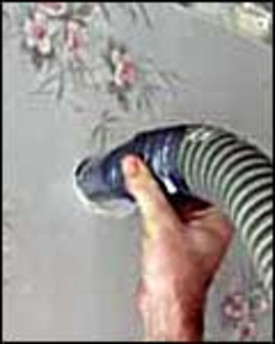 |
||
|
|
||
Fiberglass, cellulose, and foam are the most common types of blown- and sprayed-in insulation materials. And it is worth it. Retrofitting insulation into existing walls and attic space can achieve a 20 to 30 percent savings on heating bills. Determined DIY’ers can find cellulose or fiberglass blower equipment at their local rental yard, and can economically complete an attic insulation job. The learning curve and the inconvenience factor make most other blown-in applications impractical for a homeowner, and spray-in insulation should be left to the pro.
Insulation Options
Fiberglass-based blow-in insulation is a popular choice for attics and hard to reach areas. Properly applied, blown-in fiberglass insulates well. Proper technique in the application is critical. Fiberglass can be “fluffed up” if care is not taken during its application. “Overblowing” fiberglass occurs when the installer applies enough material to reach the desired depth, but with less material than is required to achieve the proper rated R-value. Manufacturer’s recommendations on coverage should be followed. Makers of fiberglass insulation list specific “depth plus density” recommendations (usually stated in bags of insulation to be applied per square foot of space) to achieve proper results.
Cellulose insulation is composed of up to 85 percent recycled newsprint. The remaining content is commonly a mixture of borate and ammonium sulfate that functions as a fire retardant. These chemicals also deter rodents, insects, and mold. Avoid materials containing formaldehyde and mineral fibers. Dry cellulose is very popular for blown-in insulation applications. Cellulose’s small particles fill voids and corners well as the material is shot into the walls. Dry cellulose offers an “itch free” installation, but respirators and safety goggles must be worn during the process. Cellulose dust is fine and tends to take a long time to settle. Cellulose can also be wet-sprayed. However, many professionals only recommend this process for unfinished spaces with exposed studs. When sprayed into existing walls, the moisture in wet cellulose applications may damage wall finishes before it dries.
Cementitious foam is a magnesium-based product that is derived from seawater. Because of its consistency, foam is the most effective product for retrofitting into existing walls. Foam will work its way around any obstacle, providing a near-100 percent wall fill (cellulose, for example, may not fill completely around bundles of wires or pipe runs and leave random voids). Unlike bottled foam insulation used to seal small gaps around pipes and wiring, it does not shrink or expand. In new construction, foam can be installed after drywall is hung, but taping and texturing drywall joints should be completed after the foam has completely dried (usually about 48 hours). Cementitious foam is the most costly insulation to retrofit, but is the most benign in regards to indoor air quality; when it is being applied into a wall there is no dust.
Credit: Renovate Your World




























